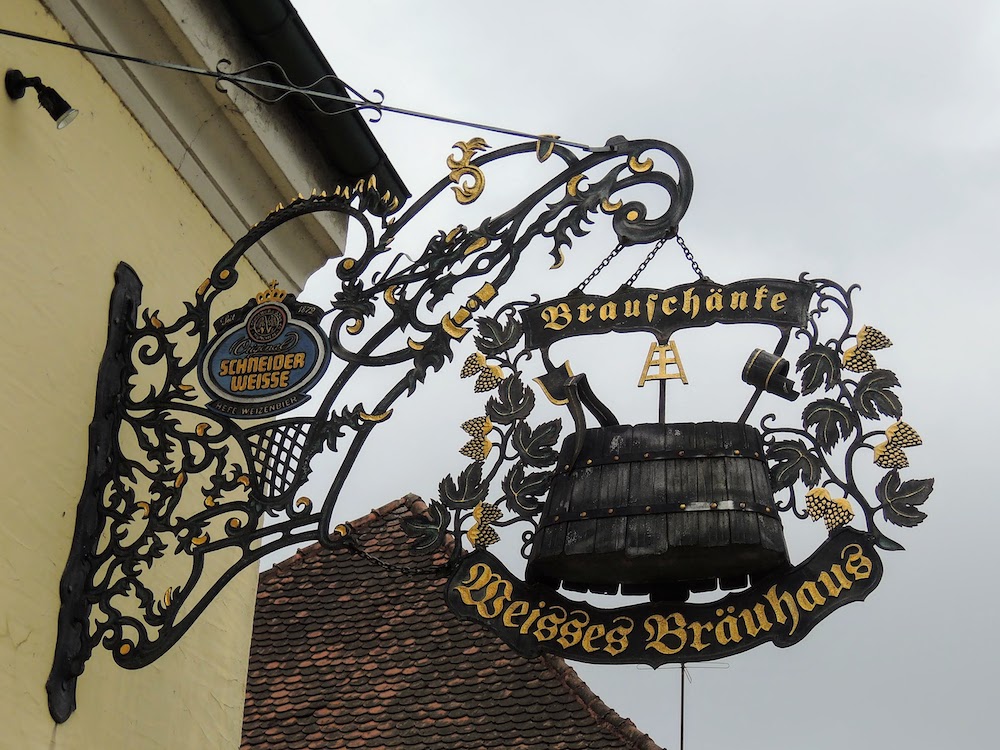The common theme through many wheat beers is the tendency of brewers to introduce spicy elements, rather as bakers add seeds, spices and herbs to their breads and cakes.

The Schneider & Sohn brewery in Kelheim is seen as the originator of modern German wheat beers (photo: André Brunnsberg)
Hefeweizen (or Hefeweiß)
Europe’s most distinctive style of wheat beer is virtually hop-free, of session strength (4.4-5.6% ABV), and cloudy. Known as Hefeweizen (literally ‘yeasty wheat’), or Hefeweiss (‘yeasty white’), its most memorable characteristics are the banana, clove and nutmeg aromas and flavours that can come from the special yeast used to ferment it. Wheat beers have existed in Bavaria for as long as brewing. The Bavarian Beer Purity Order of 1516, sometimes referred to as the Reinheitsgebot, was prompted by a price war between brewers and bakers, over wheat supplies. At what point the specialist yeast were developed is less clear, though its modern form can be traced back to the Schneider family’s brewery at Kelheim. The company had become wheat beer specialists by 1872, and still leads the world in creating new or revived forms of wheat beer. The deliberately cloudy version began regaining popularity in the 1960s. Skilled servers maximise its haze by rolling the bottom quarter of the beer, with the dregs in the bottle, and up-ending it into the rest of the beer, in its special tall glass.
Wheat beer in the Czech Republic is called pšeničné pivo and broadly follows the Bavarian model. Almost all are light in colour and most appear hazy, though a few are clear. The key thing in common is the esters in the flavour, which come from using the same yeast as their Bavarian equivalents, though there are slight differences. Czech wheat beers tend to be brewed to a slightly higher intensity, measuring 13 degrees Plato, and are allowed slightly higher hopping.
Kristallweizen (or Kristall Weiß)
If you filter Hefeweizen you will remove its flour suspension, proteins and, many would argue, much of its character, though it looks more polished.
Dunkelweizen (or Dunkles Weißbier)
Typically loaded with banana-like esters and clove-like phenolic edges, these darker Bavarian wheat beers carry some light caramel or bread crust, though roasted flavours should be absent. The same strength as Hefeweizen (4.4-5.6% ABV), the name ‘dark white’ sounds odd but is likely more typical in colour to wheat beers of old. Typically more than 50% of the grain bill is made up of barley. Some German brewers distinguish between amber and brown varieties but we are not convinced this distinction helps.
Other wheat beer styles of German origin
Weizenbier made in the north of Germany is often fermented with a lager or regular ale yeast, meaning that the banana-spice esters are absent and the beer seems drier. As the Beer Purity Order spread across a united Germany in the late 19th and early 20th centuries, it is credited, rightly or wrongly, with causing a number of historic beer styles, made locally in other other parts of northern and eastern Germany, to be outlawed. However, several older styles of wheat beer have either survived into, or been revived in the 21st century.
Berliner Weisse
This light, tart style of wheat beer (2.5-4.5% ABV) comes, as its name suggests, from Berlin. It is fermented through to dryness, with a distinct lactic edge but little hop presence. It was on the verge of extinction in its city of origin until revived by home brewers and craft producers. The “tradition” of adding coloured syrups to it is a modern affectation – a bit like adding a dollop of lime or blackcurrant cordial to an industrial lager.
Gose
This sharp-ish form of wheat beer (4.2-4.8% ABV) is associated with the eastern Germany. It may be named after the town of Goslar and is most associated with the city of Leipzig. It owes its dryness to having salt added to the mash, though this is offset by the use of a little coriander. It is believed to have been exempted from the Beer Purity Order in 1919, and remained available in the city until the 1960s. It spluttered back into existence in the years either side of the fall of the Berlin Wall, since when international imitations have proved more popular than the original. Those that contain fruit or vegetable extracts tend to be lower in alcohol, and can make effective thirst quenchers. They might even be considered as a separate style.
EBCU workshop “All About… Gose” on Youtube
Lichtenhainer
This light, sour and smoky wheat beer (3.5-4.7% ABV) appears always to have been local to Thüringen (Thuringia), in central Germany, before and after the arrival of purity. Mashed from lightly smoked barley and 30-50% unmalted wheat, it used to develop lactic ageing, though revivals in recent years achieve this by an infusion of lactobacilli.
Wheat beer styles of Belgian origin
Witbier / Bière blanche (or Tarwebier / Bière de froment)
Wit and blanche mean ‘white’, while tarwe and froment mean ‘wheat’. This simple quaffing style (4.0-5.5% ABV), low in hops and soft on the palate, is made hazy by wheat flour and spicy by additions from the spice cabinet. The most commonly used are dried citrus peel and coriander, The style had almost disappeared when brewer Pierre Celis of Hoegaarden, east of Brussels, recreated a beer he recalled from his childhood, back in 1966. For many, his was a gateway beer into the world of craft brewing. Many examples can now be found in Belgium, France, the Netherlands and further afield, the more so in summer.
Grisette
This emerging light summer beer (2.5-4.0 % ABV) lacks much written history but is claimed to have the same rustic origins as Saison Légère, though with a wheat base. It is likely a younger second cousin to a defunct, lighter form of lambic, called Meerts. it is said to have been popular in southern Belgium and parts of northeast France in the 19th and early 20th centuries, and may be about to return to popularity, with the search for tastier lighter beer styles.
See also: Lambic
Wheat beer styles from elsewhere
Grodziskie (or Grätzer)
This delightfully light style of wheat beer comes from the Polish city of Grodzisk – known as Gratz in German times. It was brewed traditionally from a mash of 100% lightly oak-smoked malted wheat, the character of which was offset by Saaz hops. The version made prior to its demise in the 1990s was typically 2.5-3.3% ABV, though examples of the revived form tend to be slightly stronger. Interest is growing with the demand for characterful lower alcohol beer styles. International interest has grown too, even as far away as Brazil. Another style that is a candidate for greater popularity with the search for most characterful light beers.
EBCU workshop “All About… Grodziskie” on Youtube.
American wheat beer
While German wheat beers are yeast led and Belgian ones a mix of doughy and spicy, an American wheat beer should be simple and light (4.0-5.5% ABV) with great drinkability, offering a platform for low-dose but nonetheless noticeable and delicate hopping. There should be no banana, clove, coriander or citrus peel character and it should have only a little haze.
An interesting French variation on Hefeweizen is emerging, with saison-like notes in its character.



